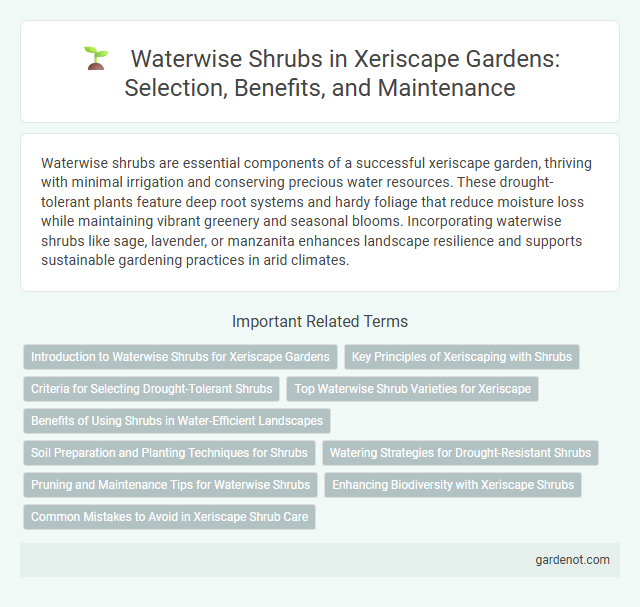Waterwise shrubs are essential components of a successful xeriscape garden, thriving with minimal irrigation and conserving precious water resources. These drought-tolerant plants feature deep root systems and hardy foliage that reduce moisture loss while maintaining vibrant greenery and seasonal blooms. Incorporating waterwise shrubs like sage, lavender, or manzanita enhances landscape resilience and supports sustainable gardening practices in arid climates.
Introduction to Waterwise Shrubs for Xeriscape Gardens
Waterwise shrubs are essential for xeriscape gardens, offering drought-tolerant solutions that reduce water consumption while maintaining visual appeal. Species such as lavender, sage, and rosemary thrive in arid conditions, requiring minimal irrigation and enhancing soil conservation. These shrubs support sustainable landscaping by promoting biodiversity and lowering maintenance costs in dry climates.
Key Principles of Xeriscaping with Shrubs
Waterwise shrubs in xeriscaping conserve water by utilizing deep root systems and drought-tolerant species suited to arid climates. Incorporating native and adapted shrubs reduces irrigation needs while maintaining landscape aesthetics and soil health. Strategic placement of these shrubs optimizes shade and wind protection, enhancing water retention and overall xeriscape efficiency.
Criteria for Selecting Drought-Tolerant Shrubs
Drought-tolerant shrubs suitable for xeriscaping must exhibit high water-use efficiency, native adaptability, and deep root systems to maximize moisture absorption and retention. Selecting species such as lavender, rosemary, or Texas sage hinges on their proven resilience to prolonged dry periods and minimal irrigation requirements. Evaluating soil compatibility and growth rate further ensures sustainable landscaping with reduced water consumption and maintenance.
Top Waterwise Shrub Varieties for Xeriscape
Top waterwise shrub varieties for xeriscape gardens include native plants like Texas sage (Leucophyllum frutescens), which thrives in dry conditions and requires minimal irrigation. Other excellent shrubs are the yaupon holly (Ilex vomitoria) and desert willow (Chilopsis linearis), both known for their drought tolerance and low water needs. These shrubs enhance landscape aesthetics while conserving water, making them ideal for sustainable xeriscaping.
Benefits of Using Shrubs in Water-Efficient Landscapes
Waterwise shrubs play a crucial role in xeriscape landscapes by significantly reducing water consumption while maintaining aesthetic appeal. These drought-tolerant plants improve soil health, prevent erosion, and provide essential habitat for local wildlife, enhancing ecosystem sustainability. Incorporating native, deep-rooted shrubs into water-efficient gardens promotes long-term resilience and lowers irrigation costs.
Soil Preparation and Planting Techniques for Shrubs
Proper soil preparation for waterwise shrubs involves improving soil drainage and incorporating organic matter to retain moisture efficiently. Planting techniques include selecting drought-tolerant shrub varieties, planting at the appropriate depth, and applying mulch to reduce evaporation and maintain consistent soil moisture levels. These practices help establish resilient xeriscape shrubs that thrive in low-water environments.
Watering Strategies for Drought-Resistant Shrubs
Waterwise shrubs thrive with deep, infrequent watering that encourages strong root development, essential for drought resistance. Incorporating mulch around the base reduces soil evaporation, maintaining consistent moisture levels and supporting shrub health during dry periods. Scheduling watering early in the morning or late evening minimizes evaporation loss, ensuring maximum water absorption for these xeriscape plants.
Pruning and Maintenance Tips for Waterwise Shrubs
Pruning waterwise shrubs such as Texas sage, oleander, and lavender promotes healthy growth and maintains their drought-tolerant characteristics by removing dead or overgrown branches during late winter or early spring. Regular maintenance, including mulching with organic material and monitoring soil moisture levels, helps conserve water while preventing root rot and pest infestations. Proper pruning techniques improve airflow and sunlight penetration, ensuring these shrubs thrive in xeriscape landscapes with minimal irrigation requirements.
Enhancing Biodiversity with Xeriscape Shrubs
Xeriscape shrubs like California lilac and Texas sage play a crucial role in enhancing biodiversity by providing native pollinator habitats and supporting local wildlife. These drought-tolerant plants require minimal irrigation, conserving water while promoting ecological balance in arid landscapes. Incorporating waterwise shrubs in xeriscaping fosters resilient ecosystems that sustain diverse insect and bird populations year-round.
Common Mistakes to Avoid in Xeriscape Shrub Care
Overwatering is a common mistake in xeriscape shrub care, as drought-tolerant species like sagebrush and manzanita require minimal irrigation to thrive. Planting waterwise shrubs in poorly drained or shaded areas disrupts their natural growth cycles and increases susceptibility to root rot and fungal diseases. Neglecting proper soil preparation, such as failing to amend with organic matter or mulch, reduces water retention and nutrient availability crucial for xeriscape shrub health.
Waterwise shrub Infographic

 gardenot.com
gardenot.com